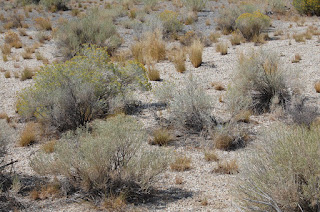 |
| The far side of the Salt Lake riding on a mirage of water |
John Bidwell recalled, 'Thus misled, we traveled all day without water, and at midnight found ourselves on a plain, level as a floor, incrusted with salt, and as white as snow...This plain became softer and softer until our poor, almost famished, animals could not pull our wagons. In fact, we were going direct to Salt Lake and did not know it.'
 |
| Try driving a wagon through this stuff |
They looped around, crossed their own tracks, struggling through sagebrush so dense that it tipped some of the lighter wagons over. In their blundering along the north end of the lake, they at last found a source of good water and sent out scouts to try and find the Mary's River. They sat in camp for over a week waiting for them to return, which they did with the news that the river was about five days march ahead. They toiled onward with their wagons, until near the present western border, one of the more forceful characters in the company had had enough. Ben Kelsey unyoked his oxen, emptied his wagon and loaded what belongings he could on their backs. On their horses he put his 18-year-old wife Nancy and their toddler daughter. The wagon would stay where it was and they would pack to California driving their oxen. Within a few days, the rest of the party had copied their example.
With this, they were no longer a wagon train, but a starving group of increasingly fractious stragglers with the dream of California in their minds. If it could be anywhere along the line of our pursuit of our ancestor, this was the place where my brothers and I would be able to see exactly where he had gone and what he had faced. The road was unpaved and the dust billowed up behind the car as we rumbled over the gravel toward the town of Lucin Utah. The thermometer in the car showed that the outside temperature was topping 90 degrees. It was a good day to be together--three brothers whose relative had done challenging things--in an air-conditioned car.
 |
| The road |
And along the way, quite by chance, in a tiny town that vanished into the landscape, we came upon another relic of more recent times--an establishment that referenced the overland trail, on our little bit of it, though so far off the beaten track of the interstate that it never had a chance.
 |
| Brother John, is he welcoming us, or warning us off? |


No comments:
Post a Comment